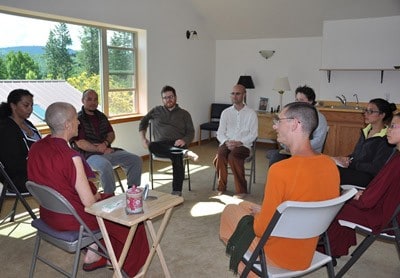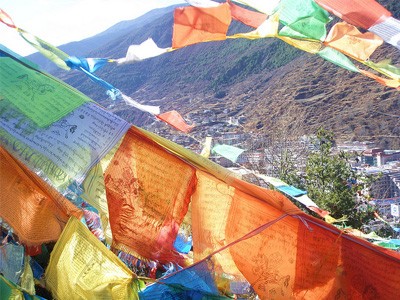Refuge groups

The purpose of a refuge group is to prepare the participants for formally taking refuge in the Three Jewels and taking any or all of the five lay precepts. Studying and discussing these topics together helps us understand them correctly and deepens our present understanding. It also gives us a forum for discussing our hesitations, doubts, and questions, and to share our insights and understandings with others. In this way, we give support to and receive support from Dharma friends as we practice the path together. Some refuge groups have found the meetings so helpful that they continue to meet from time to time after the refuge ceremony to “check in” and see how everyone is doing.
Readings
Please read and discuss in the following order:
- Refuge and precepts ceremony, by Ven. Thubten Chodron
- Taking Refuge from Open Heart, Clear Mind, by Ven. Thubten Chodron
- Refuge, by Lama Thubten Yeshe
- “Practical Guidelines for Good Living” from Taming the Mind, by Ven. Thubten Chodron
- Life Without Sila is Like a Car Without Brakes, by Bhikkhu Ajahn Amaro
- Introduction and precept chapters from For a Future to Be Possible, by Thich Nhat Hanh
- The Healing Power of the Precepts, by Thanissaro Bhikkhu
- Guidelines for the Practice of Refuge from Pearl of Wisdom, Book 1
- Refuge and Precept Discussion Questions, by Ven. Thubten Chodron
Format
The group meets together as often and as many times as it likes until the people in it have completed studying and discussing the readings, and until they feel prepared to take refuge and precepts. At the beginning of each meeting, one person should lead a brief motivation and then initiate the discussion, either sharing some of his or her ideas, or posing some questions for everyone to think about. People should talk personally and honestly and share their reflections and experiences—that’s how to develop Dharma friendships and how to give and receive help with doubts.
Multiple interpretations
As you will see from the readings, there are various interpretations of refuge and precepts. This is to get us to think more deeply and to help us become more aware of our actions. We must distinguish breaking a precept from the root from committing a minor transgression, and these also differ from expanding the meaning of the precept to things not specifically mentioned in it.
For example, to break the precept of avoiding killing from the root, one must kill a human being with all the parts of the action intact (i.e. one has identified the person to kill, has the intention to kill, kills the person, the other person dies before oneself, and one rejoices at having killed). This is different from putting an animal to sleep, which is a minor transgression of the precept, not a complete one. Such an action still should be abandoned, but it is not as severe if it is done. The precept to avoid stealing is broken from the root if one steals something of enough value that the legal system in the country would hold one accountable for stealing.
The precept to avoid unwise sexual contact is broken from the root if one commits rape, if one has a sexual relationship outside one’s committed relationship, or if one is single and the other person is in a committed relationship. Less heavy transgressions would include, unprotected sex where there is possibility of transmitting disease, and using others for our own pleasure—even if they consent— when there is a likelihood of them getting hurt. The precept to avoid lying is broken from the root by claiming to have spiritual attainments that one knows one does not have. Since the precept against intoxicants does not involve a naturally negative action (i.e. an action which by its nature is negative), there is not the division into breaking it from the root and committing a minor transgression.
The boundaries of some precepts may vary according to the preceptor giving them. For example, I give the intoxicant precept in a very clear way: no alcohol, recreational drugs or tobacco, not even a very tiny amount!
The meaning of each precept can be expanded from what is written, and this is helpful for increasing our awareness. However, when we take a precept, we are committing ourselves to following it only as it is written. For example, if we expand the meaning of abandoning intoxicants, it could refer to stopping any intoxicating activity, i.e. anything we do to distract or “intoxicate” ourselves, for example, space out by watching TV, going shopping when we are bored, and so on. Certainly, it would be to our advantage to abandon all activities done with a motivation seeking distraction, however, it is not required that we do this when we take the intoxicant precept. The precept itself refers to abandoning only alcohol, recreational drugs and tobacco (that’s already a lot!).
Each person may take any or all of the five precepts at the time of taking refuge. Each person should let me know which precepts he or she wishes to take.
For Further Study and Exploration
For questions to stimulate further exploration, see the section “Refuge and Precept Discussion Questions.”
For a compilation of additional teachings on the meaning and benefits of taking refuge in the Three Jewels, see this webpage of online teaching resources.
Recommended Reading
The Library of Wisdom and Compassion by His Holiness the Dalai Lama and Ven. Thubten Chodron, published by Wisdom Publications:
- Volume 1: Approaching the Buddhist Path
- Volume 2: The Foundation of Buddhist Practice
- Volume 3: Samsara, Nirvana, and Buddha Nature
- Volume 4: Entering the Buddhist Path: The Three Jewels and the Three Higher Trainings
The Compassionate Kitchen: Buddhist Practices for Eating with Mindfulness and Gratitude by Ven. Thubten Chodron, published by Shambhala Publications
Venerable Thubten Chodron
Venerable Chodron emphasizes the practical application of Buddha’s teachings in our daily lives and is especially skilled at explaining them in ways easily understood and practiced by Westerners. She is well known for her warm, humorous, and lucid teachings. She was ordained as a Buddhist nun in 1977 by Kyabje Ling Rinpoche in Dharamsala, India, and in 1986 she received bhikshuni (full) ordination in Taiwan. Read her full bio.


